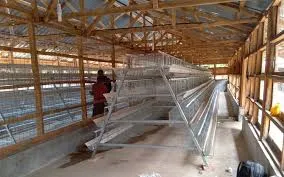chick rearing cage
Nov . 25, 2024 22:39 Back to list
chick rearing cage
Chick Rearing Cage A Comprehensive Guide
Chick rearing cages have become an essential component in poultry farming, especially for small to medium-sized producers who aim to rear chickens efficiently while maintaining optimal health and growth conditions. In this article, we will delve into the importance of chick rearing cages, their design features, and best practices for chicken raising.
Importance of Chick Rearing Cages
Chick rearing cages provide a controlled environment that enhances the welfare and growth of chicks. Unlike traditional floor systems, cages allow for better management of resources such as space, food, water, and litter. The controlled environment reduces the risk of disease and increases productivity, leading to healthier chickens and, ultimately, better profits for farmers.
One of the primary advantages of using cages is the reduction in mortality rates among chicks. Diseases like bronchitis and coccidiosis can spread rapidly in over-crowded or poorly managed environments. Cages minimize contact between individuals, thereby reducing the transmission of these diseases. Furthermore, they allow for easier monitoring of chick health and behavior, enabling quicker intervention when issues arise.
Design Features of Chick Rearing Cages
The design of chick rearing cages is pivotal in ensuring the well-being of the birds
. Here are several crucial features that should be incorporated into any effective chick rearing system1. Ventilation Proper airflow is essential to prevent the buildup of harmful gases like ammonia, which can irritate the respiratory systems of the chicks. Cages should be designed to facilitate adequate ventilation while protecting the chicks from drafts.
2. Feeding and Watering Systems Automatic feeding and watering systems can greatly enhance efficiency. These systems should be easily accessible and ensure that all chicks can feed and drink without excessive competition.
3. Space Allowance It's vital to provide adequate space within the cages. Overcrowding can lead to aggressive behaviors and stress among chicks. A general guideline is to provide at least 0.5 square feet per chick, expanding this figure as the chicks grow.
4. Litter Management While some rearing systems use litter, cages often employ slatted floors or wire to minimize litter buildup. This design feature makes it easier to maintain cleanliness and helps prevent diseases associated with dirty environments.
chick rearing cage

5. Monitoring Systems Incorporating biosecurity measures such as surveillance cameras can help monitor the chicks without causing disturbance. This allows farmers to keep an eye on unusual behavior, health issues, or incidents that may require immediate attention.
Best Practices for Using Chick Rearing Cages
To maximize the advantages of chick rearing cages, it is critical to adhere to best practices in management and care
1. Initial Setup Before introducing chicks, ensure that the cage is fully cleaned and disinfected. Pre-warm the environment to a suitable temperature to provide a comfortable and welcoming atmosphere.
2. Gradual Introduction When introducing chicks into the cages, do so gradually to minimize stress. Monitor their behavior closely during this transition.
3. Regular Monitoring Keep a daily log of the health and behavior of the chicks. Watch for signs of distress or illness, such as lethargy or abnormal eating patterns.
4. Routine Maintenance Regularly clean feeding and watering systems to prevent any contamination. Change bedding materials or clean slatted floors to maintain a healthy environment.
5. Educate Yourself Stay updated on best practices and innovations in poultry farming. Participating in workshops, webinars, or online forums can provide valuable insights and enhance your rearing techniques.
Conclusion
Chick rearing cages are a remarkable advancement in poultry management, promoting healthier birds and more efficient farming practices. By investing in the right cage design and adhering to best management strategies, farmers can enjoy higher productivity while nurturing the chickens that serve as a staple in our food supply. As the poultry industry continues to evolve, embracing the advantages of cage rearing is essential for both economic viability and animal welfare.
-
Automatic Feeding Line System-Pan Feeder Nipple Drinker|Anping County Yize Metal Products Co., Ltd.
NewsJul.29,2025
-
Hot Sale 24 & 18 Door Rabbit Cages - Premium Breeding Solutions
NewsJul.25,2025
-
Automatic Feeding Line System Pan Feeder Nipple Drinker - Anping County Yize Metal Products Co., Ltd.
NewsJul.21,2025
-
Automatic Feeding Line System Pan Feeder Nipple Drinker - Anping County Yize Metal Products Co., Ltd.
NewsJul.21,2025
-
Automatic Feeding Line System - Anping Yize | Precision & Nipple
NewsJul.21,2025
-
Automatic Feeding Line System - Anping Yize | Precision & Nipple
NewsJul.21,2025






